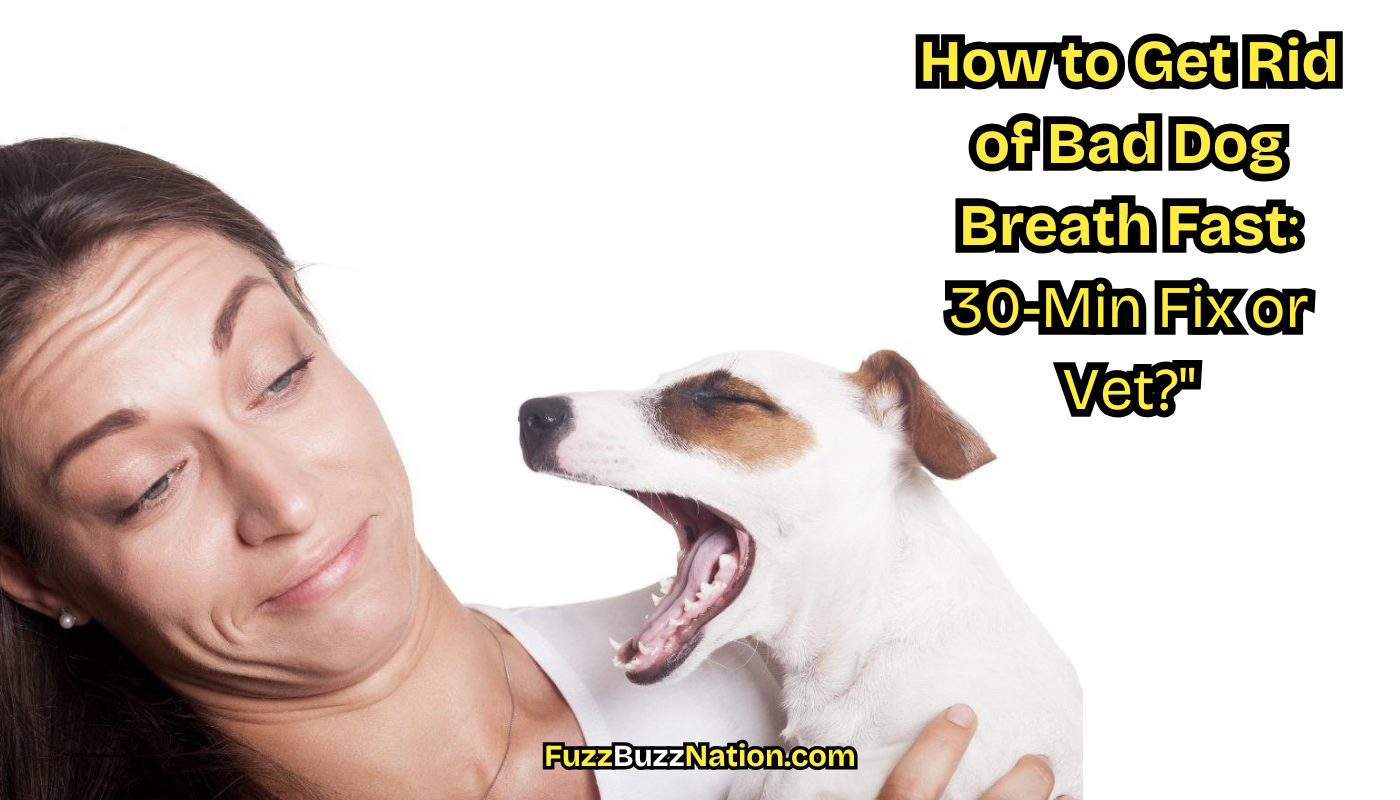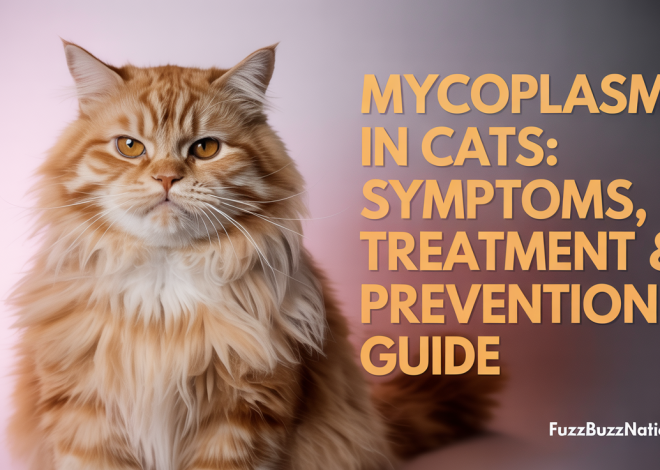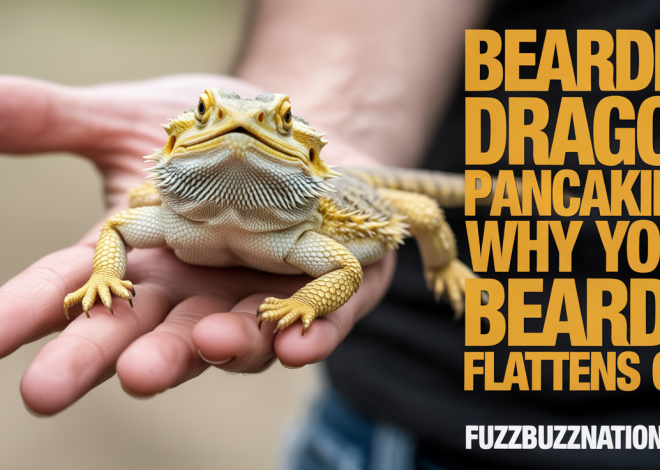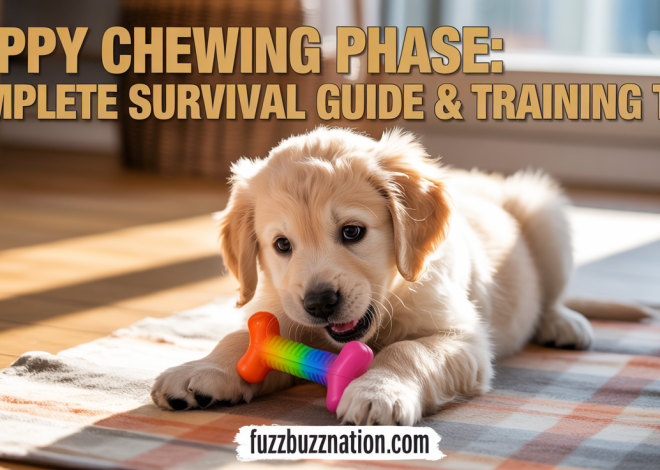
How to Get Rid of Bad Dog Breath Fast: 30-Min Fix or Vet?
The fastest way to improve bad dog breath is brushing their teeth with dog-safe toothpaste, offering dental chews, or giving them coconut oil—all can provide noticeable improvement within 30 minutes to 2 hours. However, breath that smells like urine, ammonia, or rotting meat requires immediate veterinary attention as it signals serious health emergencies including kidney disease, liver failure, or oral tumors.
Understanding the difference between treatable bad breath and medical emergencies can literally save your dog’s life. While most dog owners assume bad breath is normal, veterinarians now use breath odor as a diagnostic tool for detecting serious health conditions before other symptoms appear. The key is knowing which solutions work fast for common causes and when to drop everything and head to the emergency vet.
The 30-Minute Bad Breath Solutions That Actually Work
When you need immediate results for typical bad breath caused by plaque buildup or eating something gross, several proven methods can provide noticeable improvement within 30 minutes to 2 hours. These solutions work by either mechanically removing odor-causing bacteria or neutralizing the smell at its source.
Brushing your dog’s teeth with canine toothpaste represents the most effective immediate intervention for plaque-related bad breath. The mechanical action removes food particles and disrupts bacterial colonies, while dog-safe toothpaste contains enzymes that continue working after brushing. Never use human toothpaste, as xylitol and other ingredients can be toxic to dogs. If your dog resists brushing, try finger brushes or dental wipes as alternatives.
Dental chews specifically designed for breath freshening can provide rapid results, particularly those approved by the Veterinary Oral Health Council. The chewing action scrapes away surface plaque while the textured surface reaches areas a toothbrush might miss. Look for chews containing chlorophyll, parsley, or mint for additional odor-fighting properties. Size the chew appropriately—too small creates choking hazards while too large may discourage chewing.
Coconut oil offers antimicrobial properties that can rapidly reduce odor-causing bacteria in your dog’s mouth. Start with 1/4 teaspoon for small dogs or 1/2 teaspoon for larger dogs, allowing them to lick it from a spoon. The lauric acid in coconut oil has antibacterial, antifungal, and antiviral properties that begin working immediately. However, introduce coconut oil gradually to avoid digestive upset, and reduce regular food portions to account for the added calories.
Water additives designed for dogs can provide quick breath freshening when added to their drinking bowl. These products typically contain enzymes that break down odor-causing bacteria or chlorophyll compounds that neutralize smells. While not as immediately effective as direct interventions, they begin working as soon as your dog takes their first drink and continue working throughout the day.
The Warning Breath Smells That Mean “Emergency Vet NOW”
Certain breath odors indicate serious medical emergencies requiring immediate veterinary attention, regardless of the time of day or cost concerns. These distinctive smells often appear before other symptoms and can provide crucial early warning of life-threatening conditions.
Urine or ammonia-scented breath signals potential kidney disease or kidney failure, conditions that can progress rapidly to life-threatening toxicity. When kidneys fail to filter toxins properly, urea builds up in the blood and can be detected on the breath. This symptom often appears before increased thirst, changes in urination, or obvious illness signs. Dogs with kidney disease may seem normal aside from the distinctive breath odor, making this smell a critical early warning sign.
Sweet, fruity breath resembling nail polish remover or acetone indicates possible diabetic ketoacidosis, a potentially fatal complication of diabetes. This occurs when the body breaks down fat for energy instead of glucose, producing ketones that create the distinctive sweet smell. Diabetic ketoacidosis can progress rapidly to coma and death without immediate treatment. Other symptoms may include excessive thirst, frequent urination, vomiting, and lethargy.
Breath that smells like rotting meat or dead tissue often indicates oral tumors, severe infections, or tissue death (necrosis) in the mouth. These conditions can develop quickly and may not be visible during casual mouth inspection. Oral cancers are more common in older dogs but can occur at any age, and early detection significantly improves treatment outcomes.
Excessively foul breath accompanied by yellow-tinged gums, vomiting, loss of appetite, or lethargy may indicate liver disease or liver failure. The liver processes many toxins, and when it fails, these substances accumulate and can be detected on the breath. Liver disease can progress rapidly, particularly in cases involving toxin exposure or acute infections.
The Popular Home Remedies That Don’t Work (And Could Be Dangerous)
Many commonly suggested home remedies for dog bad breath are either ineffective or potentially harmful, wasting valuable time when professional treatment might be needed. Understanding which remedies to avoid can prevent accidental poisoning or delayed treatment of serious conditions.
Mint-flavored human products including mints, gum, or toothpaste should never be given to dogs. Many contain xylitol, an artificial sweetener that’s extremely toxic to dogs and can cause rapid hypoglycemia, liver failure, and death. Even xylitol-free mint products often contain other ingredients that can upset your dog’s digestive system or mask serious underlying problems.
Baking soda, while often recommended for its deodorizing properties, can be dangerous for dogs when used regularly or in large amounts. Dogs that lick baking soda from their teeth can experience electrolyte imbalances, particularly problematic for dogs with heart or kidney conditions. Additionally, baking soda’s abrasive nature can damage tooth enamel with regular use.
Essential oils including tea tree, peppermint, or eucalyptus should never be used in your dog’s mouth, even when diluted. Many essential oils are toxic to dogs and can cause liver damage, neurological problems, or severe digestive upset. The concentrated nature of essential oils makes even small amounts potentially dangerous.
Hydrogen peroxide, sometimes suggested for oral care, should only be used under veterinary guidance and never as a regular breath treatment. While occasionally used to induce vomiting in poisoning cases, hydrogen peroxide can cause stomach irritation, chemical burns in the mouth, and foam formation that may be inhaled into the lungs.
Apple cider vinegar, despite its popularity in home remedies, can damage tooth enamel when used regularly and may upset sensitive stomachs. While small amounts are generally safe, the acidic nature can worsen dental problems rather than improving them, particularly in dogs with existing oral issues.
The Science Behind Why Some Dogs Have Worse Breath Than Others
Understanding the factors that predispose certain dogs to bad breath helps owners develop targeted prevention strategies and realistic expectations for treatment outcomes. Some dogs face greater challenges due to genetics, anatomy, or lifestyle factors beyond owner control.
Breed-specific anatomical features significantly impact breath quality, with brachycephalic breeds (flat-faced dogs like pugs, bulldogs, and Boston terriers) experiencing more dental problems due to crowded teeth and altered jaw structure. The compressed facial anatomy creates tight spaces where food and bacteria accumulate more easily, while the altered jaw alignment can prevent proper tooth cleaning through natural chewing actions.
Smaller dog breeds often develop dental problems earlier and more severely than larger dogs due to proportionally larger teeth in smaller mouths, creating overcrowding that traps food and bacteria. The rapid metabolism of small dogs may also contribute to faster plaque formation, while their tendency toward selective eating can result in softer diets that don’t provide natural teeth cleaning benefits.
Age-related changes affect all dogs but become more pronounced after age 7, when decreased saliva production reduces the mouth’s natural cleaning mechanisms. Senior dogs may also develop underlying health conditions that contribute to bad breath, while decreased activity levels can reduce natural teeth cleaning from chewing and play activities.
Diet composition dramatically impacts breath quality, with high-protein diets potentially creating stronger odors during digestion, while soft or wet foods provide less natural teeth cleaning than dry kibble. Dogs that scavenge, eat feces, or consume human food scraps face additional breath challenges from inappropriate dietary choices.
Individual bacterial populations in the mouth vary significantly between dogs, with some naturally harboring more odor-producing bacteria regardless of dental care efforts. These variations can be influenced by genetics, previous antibiotic use, overall immune system health, and exposure to different environmental bacteria throughout the dog’s life.
The Professional Solutions That Work When Home Remedies Fail
When home interventions don’t provide adequate improvement, professional veterinary treatments offer more powerful solutions for addressing underlying causes of persistent bad breath. These treatments target specific conditions that home care cannot effectively address.
Professional dental cleaning under anesthesia allows veterinarians to remove tartar below the gum line, assess tooth health through X-rays, and perform necessary extractions of damaged teeth. This comprehensive approach addresses the root causes of dental-related bad breath that surface cleaning cannot reach. The procedure includes scaling, polishing, and evaluation of each tooth’s health status.
Prescription antibiotics may be necessary for dogs with oral infections, gum disease, or systemic conditions contributing to bad breath. These medications target specific bacterial populations that over-the-counter products cannot eliminate. Your veterinarian will select appropriate antibiotics based on culture results or clinical presentation.
Specialized diets formulated for dental health can provide ongoing support for dogs with chronic breath problems. These foods feature specific kibble shapes, textures, and ingredients designed to mechanically clean teeth while promoting oral health. Some prescription diets also contain enzymes or other additives that help control odor-causing bacteria.
Treatment of underlying systemic diseases requires professional veterinary care and may include medications for diabetes, kidney disease, liver problems, or other conditions contributing to bad breath. These treatments address the root causes rather than just masking symptoms, leading to more effective and lasting improvement.
Oral surgery may be necessary for dogs with oral tumors, severe periodontal disease, or structural abnormalities contributing to chronic breath problems. Early intervention often provides better outcomes and may prevent more extensive procedures later.
Creating a Daily Routine That Prevents Bad Breath Before It Starts
Prevention strategies implemented consistently can dramatically reduce the likelihood of developing serious bad breath problems while maintaining your dog’s overall oral health. Developing sustainable routines increases compliance and long-term success.
Daily tooth brushing represents the gold standard for oral hygiene, but success depends on gradual introduction and positive associations. Start by simply touching your dog’s mouth and teeth, gradually introducing the toothbrush and toothpaste over several weeks. Use high-value treats and praise to create positive associations, and keep initial sessions very brief to prevent stress.
Strategic treat selection can support oral health throughout the day, with dental chews, raw bones (appropriate size for your dog), and dental treats providing mechanical cleaning action. Rotate different types to maintain interest while targeting different areas of the mouth. Always supervise chewing sessions and remove items that become small enough to pose choking hazards.
Water additives or dental rinses designed for dogs can provide continuous breath freshening and bacterial control throughout the day. These products work best when used consistently and in conjunction with other oral care measures. Change water daily to maintain freshness and effectiveness.
Regular veterinary dental examinations allow early detection and treatment of problems before they become serious. Annual dental assessments should include visual examination, discussion of home care effectiveness, and recommendations for professional cleaning when appropriate. Senior dogs or those with ongoing dental issues may benefit from more frequent evaluations.
Environmental management includes controlling access to breath-compromising items like garbage, feces, or inappropriate food items. Baby gates, leash supervision, and taste deterrents can help prevent many dietary causes of bad breath while protecting your dog from more serious health risks.
Your Most Urgent Questions About Dog Bad Breath Answered
How quickly can I expect to see improvement after starting treatment? Simple bad breath from food particles or minor plaque buildup often improves within 30 minutes to 2 hours with brushing or dental chews. More significant improvement from established plaque or mild dental disease typically takes 3-7 days of consistent treatment. However, if you see no improvement after a week of proper home care, veterinary evaluation is recommended to rule out underlying health issues.
What breath smells require immediate emergency veterinary care? Breath that smells like urine or ammonia (kidney disease), sweet or fruity like nail polish remover (diabetes), or like rotting meat (oral tumors/infections) requires immediate veterinary attention. These odors often appear before other symptoms and can indicate life-threatening conditions. Don’t wait for additional symptoms—seek emergency care immediately.
Can I use human toothpaste or mouthwash on my dog? Never use human dental products on dogs. Human toothpaste contains xylitol, which is extremely toxic to dogs and can cause liver failure and death. Fluoride and other ingredients in human products can also be harmful. Always use products specifically formulated for dogs, which are safe if swallowed and formulated for canine mouth pH.
How often should I brush my dog’s teeth to prevent bad breath? Daily brushing provides optimal results, but 3-4 times weekly can be effective for many dogs. Consistency matters more than frequency—regular brushing every other day is better than sporadic daily attempts. Start slowly with shorter sessions and gradually increase duration as your dog becomes comfortable with the routine.
What should I do if my dog won’t let me brush their teeth? Start with finger brushes or dental wipes, which are less intimidating than toothbrushes. Introduce the process gradually over several weeks, beginning with just touching their mouth and teeth. Use high-value treats and positive reinforcement. Dental chews, water additives, and oral gels can provide alternative cleaning if brushing remains impossible.
When Bad Breath Becomes a Relationship Problem (And How to Fix It)
Dog bad breath doesn’t just affect your pet’s health—it can strain the human-animal bond and create social embarrassment that impacts your relationship with your dog. Many owners unconsciously begin avoiding close contact, reducing cuddle time, and feeling self-conscious about their dog around guests.
The psychological impact of persistent bad breath often leads to decreased interaction quality, with owners pulling away during greeting rituals, avoiding face-to-face bonding activities, and feeling apologetic about their dog’s presence around visitors. This distancing can affect your dog’s emotional wellbeing and reduce the stress-reducing benefits that close human-animal contact provides for both species.
Addressing bad breath systematically often strengthens rather than strains the relationship through increased handling during dental care routines, positive training experiences during tooth brushing introduction, shared success as breath improves, and restored close physical contact as the problem resolves. Many owners report feeling closer to their dogs after successfully implementing oral care routines.
Social considerations include preparing guests for your dog’s condition while working on solutions, having breath-freshening treats available before social interactions, focusing conversations on your dog’s positive qualities rather than apologizing for breath issues, and celebrating improvements as they occur to maintain motivation for continued care.
The long-term relationship benefits of addressing bad breath extend beyond eliminating the odor to include improved overall health through better oral care, increased confidence in social situations, restored enjoyment of close bonding activities, and the satisfaction of providing comprehensive care for your beloved companion.
Taking action to address your dog’s bad breath—whether through immediate home remedies or professional veterinary care—represents an investment in both their health and your relationship quality. The solutions exist, the products are available, and the knowledge is accessible. What matters most is recognizing that bad breath isn’t just a cosmetic issue to endure, but a solvable problem that deserves attention for the sake of your dog’s health and your mutual enjoyment of each other’s company.


